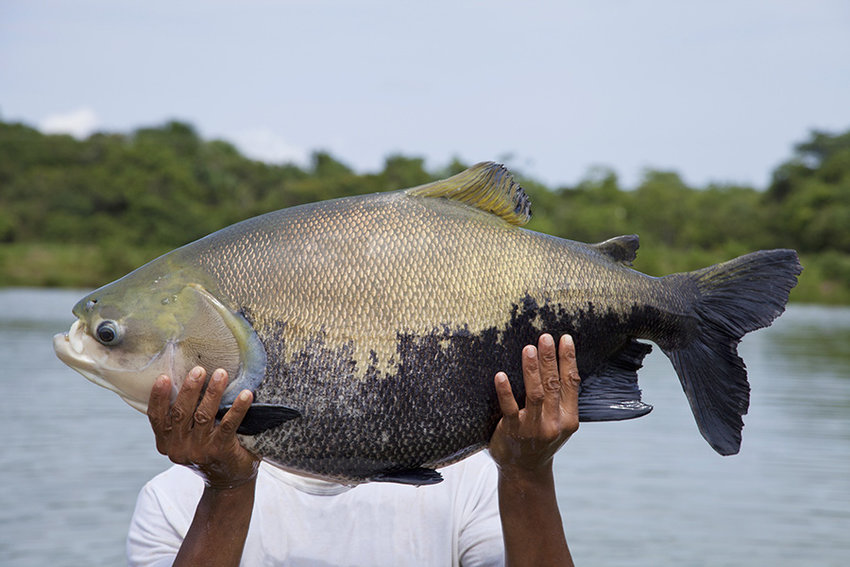RIO DE JANEIRO, BRAZIL – A fish species with high fry production, high growth rates, a primarily vegetarian diet, resistance to low amounts of oxygen in the water, and good market demand is a fish farmer’s dream.
Without significant investments in innovation and genetic improvement, the tambaqui, also known as black pacu or black cachama (Colossoma macropomum), met these characteristics and reached an annual production of 100,000 tons of fish in Brazil, behind only tilapia, with around 500,000 tons.
The difference between the two species is that the African species were subject to an extensive breeding program starting in the 1980s in Asia. The improved variety – known as GIFT (genetically improved farmed tilapia) – is currently produced in 14 countries, including Brazil, and has a chain of companies dedicated to researching and developing products for this market.

Because of its natural characteristics, the tambaqui, a fish native to Amazonian rivers, is considered by scientists to have great market potential in Brazil and globally, with the prospect of becoming a true Brazilian commodity. However, according to researchers in an article published in the journal Reviews in Aquaculture, there is a lack of investment in innovation.
“An Amazonian fish, with a 75% vegetarian diet and very easy handling, has enormous potential as a sustainable product, at a time when aquaculture is under attack due to the environmental impacts caused by the farming of salmon, for example, the first fish to become an international commodity,” says Alexandre Hilsdorf, first author of the study, who is a professor and researcher at the Integrated Biotechnology Center of the University of Mogi das Cruzes (UMC), in the state of São Paulo, Brazil.
This work brings together the most current knowledge on various aspects of tambaqui farming, from the history of fish farming in Brazil – the first attempts at domestication date back to the 1930s – through production systems, genetics, nutrition, and diseases, to processing methods.
GENETIC IMPROVEMENT
Part of the scientific production concerning this fish species in recent years has been supported by the São Paulo State Research Support Foundation (FAPESP), which financed research by some of the authors of the work, such as Hilsdorf himself, coordinator of the project entitled “Integrated study of quantitative genetics and genomics of characteristics of zootechnical interest in tambaqui (Colossoma macropomum)”.
The researcher was responsible for the sequencing and analysis of the species’ genome, published in September 2021. Hilsdorf also coordinated the study that characterized the tambaqui without intermuscular spines, those in the shape of “Y” located inside the flesh of some species. Another study identified genes possibly associated with the absence of these spines in tambaqui.
In a previous work, his group estimated the genetic parameters of several characteristics of tambaqui, such as those that determine the area of the loin, one of the cuts most appreciated by consumers. Together, this work establishes scientific parameters for developing improved genetic varieties for the market.
“The pork loin, for example, was the subject of genetic improvement. The pork breeds we currently have in Brazil were selected so that they have a reduced fat layer and an increase in the area of the loin. The improvement can make the tambaqui cuts known as loin, band, and rib result in even better products than the current ones,” explains the researcher.
Amazonas State capital, Manaus, is the leading consumer market for tambaqui. While in the 1970s, the city depended almost entirely on fishing to supply the demand for this fish. Today, its primary suppliers are fish farmers in the neighboring states Acre, Rondônia, and Roraima.
In the restaurants of Manaus, this fish – out of the wild, the animal easily reaches ten kilos – was replaced by the young specimens raised in captivity, which weigh between two and three kilos. “Restaurant owners prefer the latter, a more standard product,” says Hilsdorf.
Paradoxically, the characteristics that make captive breeding of this animal so advantageous end up pushing away investments in breeding. Matrices, fish that serve as broodstock, are still purchased from other fish farmers or even caught in the wild.
The high production of fry (young fish), their rapid growth compared to other species (they can reach two kilos in one year), and their resistance to environments with little oxygen, mean that producers do not invest in breeding.
“Not investing because the species already has a good yield is the wrong reasoning. If this fish reaches two kilos in one year, with breeding, it could reach that weight in nine months. Producers who invest in it will start selling fry or parent stock to their neighbors and will be ahead in the market. It is a long-term, risky investment, but history shows that it has a return,” says the researcher.
These fish live in a temperature range between 25°C and 34°C, which restricts their cultivation to northern Brazil. The development of varieties resistant to lower temperatures, for example, could make fish farming feasible in the rest of the country.
Instead, the solution found was the development of hybrids with species that live further south of the equator, such as the white pacu or white cachama (Piaractus mesopotamicus), whose crossbreeding results in the tambacu, and with the red cachama, red-bellied pacu, or pirapitinga (Piaractus brachypomus), which originated the tambatinga.
“We have sufficient genetic resources to develop varieties with different profiles of tolerance to cold, low oxygen in the water, diseases, without spines, and higher production of offspring and meat. We do not need to produce hybrids, which constitute a risk for maintaining the integrity of wild genetic resources due to escapes from fish farming. Producers must go beyond this and search for genetically superior products to secure economically and ecologically sustainable fish farming. This is what the world market is currently demanding,” concludes the researcher.

